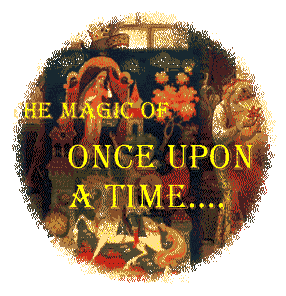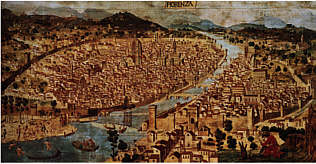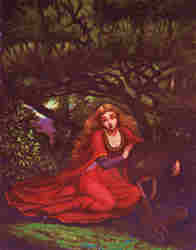|

Narrative Logo - Click for Main
Menu
Lecture III: The Characteristics and History of the Oral Tale
Nature of
Historical Change and
The place of
Folktales in Literature
Tales enchant us for several reasons. They beguile us because
they are always changing, because they are often told in an atmosphere of intimacy,
because they are sometimes more daring and exciting than what appears in print, and
because they necessarily speak to our deepest hopes and fears in a sensory, imaginative
way. Most of all, they persist - a quality that carries infinite implications, in
itself.
In addition to the kinds of changes that occur through
individual tellings, the shifting of a tale to please the audience, the character of the
teller, etc., there are large-scale changes that occur in legendstock for impersonal, historical reasons. We can explain permanent changes this way.
Sometimes the whole culture colludes in the alteration or the extinction of a tale.
Obsolescence
Consider the interpretations that we find in Marvin Harris'
incredible accounts in Cows, Pigs, Wars, and Witches. According to Harris,
cultures discover practices that are useful and contribute to the survival of the group.
They then, quite unconsciously, construct various rituals and dogma that encourage
the perpetuation of these practices. But what happens when environmental, economic,
social, or historical conditions change? What happens to the folklore that supported
the once-useful practice? Some ideas that become archaic simply disappear. In
other cases, the material is "modernized." And, in other cases, cultures
have a stubborn memory, keep the dogma long after the practice is defunct.

Caption: Representation of a medieval city at
a bend in a river. . . tidy and nice
Think, for example, of how much folk material takes
place in a "city" like this - one that is on a river, well
organized, small enough to draw a picture of! We rarely live in places like
this any more - and so our stories about where we live must change,
too! Folklore changes for other, big reasons, as well:
Attrition
Outright loss
Cultural Destruction
Omissions

Caption: Red Riding Hood (adolescent) in the
woods
Eleanor Vere De Boyle--illustrator
and, with the age of print, the inevitable
Print Censorship
The following quotations speak for themselves:
In this new edition we have carefully removed every expression
inappropriate for children. -- Jacob and Wilhelm Grimm, preface to the 1819 edition of
their
Kinder- und Hausmärchen (Children's and Household Tales).
And now, before the translator takes leave of his readers for
the second time, he will follow the lead of the good godmother in one of these tales, and
forbid all
good children to read the two which stand last in the book [Tom Totterhouse" and
"Little Annie the Goose-Girl"]. -- George Webbe Dasent, preface to the
second edition (1859) of his translation of Popular Tales from the Norse by Peter Christen
Asbjørnsen and Jørgen Moe (Edinburgh: David Douglass, 1888),
p. vi.
Many parts [of the old Cornish folk plays] are omitted, as they
would in our refined days, be considered coarse; but as preserving a true picture of a
peculiar
people, as they were a century and a half or two centuries since, I almost regret the
omissions. -- Robert Hunt, Popular Romances of the West of England
(London: John Camden Hotten, 1871), p. 395.
"The Swineherd" has certain traits in common with an old
Danish folktale, but the version I heard, as a child, would be quite unprintable. -- Hans
Christian
Andersen, "Notes for Fairy Tales and Stories" (1874), The Complete Fairy Tales
and Stories (Garden City: Anchor Press/Doubleday, 1983), p. 1073).
I have had to omit a certain number of stories as unsuited for
publication. -- Cecil Henry Bompas, preface to Folklore of the Santal Parganas (London:
David Nutt, 1909), p. 7.
Whenever an original incident, so far as I could penetrate to it,
seemed to me too crudely primitive for the children of the present day, I have had no
scruples in
modifying or mollifying it, drawing attention to such bowdlerization in the somewhat
elaborate notes at the end of the volume. -- Joseph Jacobs, preface to
European Folk and Fairy Tales (New York: G. Putnam's Sons, 1916), p. viii.
A few (four or five) of the stories are frankly indecent, and
are always expurgated from popular editions of the work in Italy, a course which I have
followed
here. Two or three of the present collection are also a trifle free, but I have decided to
leave them in their place, with a few unimportant excisions and
alterations. -- Edward Storer's introduction to his translation of Il Novellino: The
Hundred Old Tales (London and New York: George Routledge and Sons
and E. P. Dutton and Co., ca. 1925), pp. 31-32.
Being productions of a more outspoken age, many of the following
tales are, as was to be expected, of a character that is contrary to the taste of the
present
time. I have, however omitted nothing in this book; but in the case of a few isolated
passages and of three entire stories, the nature of which is such as to
preclude the possibility of their publication in these days, I have been content to print
the original transliterated into the Roman alphabet, but untranslated. -- E.
J. W. Gibb, preface to his translation from the Turkish of The History of the Forty
Vezirs; or, The Story of the Forty Morns and Eves by Sheykh-Zada
(London: George Redway, 1886), pp. xx-xxi.
Folklore, then is always
changing. It changes as a result of the passage of history and time in
its oral form and it is materially changed by the historical process of
publication.
The place of Folktales in Literature
The transmission of folk tale to printed
book - fixing the audience.
As it stands today, we maintain an uneasy balance
between the oral material we still reference and the print incarnations of these tales.
In the same way that "pagan" practices went underground during the height
of the Christian centuries, oral material keeps getting invented and passed around in a
modality quite separate from the commercial channels or the officially-sanctioned
literature.
end Lecture Notes
Return to Menu
|


